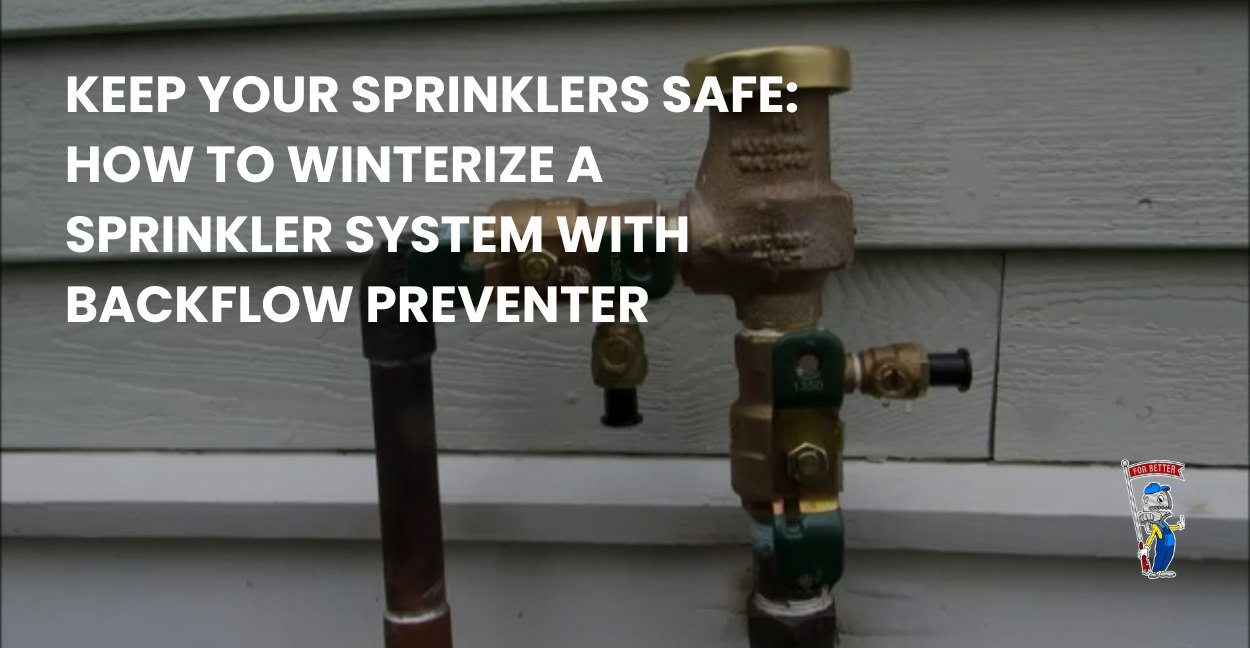As the chill of winter approaches, protecting your sprinkler system becomes essential to avoid costly repairs and ensure its longevity. One crucial aspect of winterization is safeguarding your backflow preventer, a device designed to keep contaminated water from flowing back into your home’s water supply. Properly winterizing your sprinkler system helps prevent frozen pipes, cracked valves, and damaged backflow preventers, which can lead to expensive repairs in the spring. By following the correct winterization process, you can ensure that your system is protected from the harsh winter elements and ready for use when the warmer months return. This article will walk you through how to winterize a sprinkler system with backflow preventer effectively, ensuring it remains safe and functional year-round.
Why Winterizing Your Sprinkler System Matters
Winterizing your sprinkler system is vital because freezing temperatures can cause water to expand inside your pipes, leading to cracks and leaks. This expansion can cause significant damage to the system, including broken pipes, malfunctioning valves, and damaged sprinkler heads. Additionally, water left inside the system can damage the backflow preventer, a critical component that keeps contaminants from entering your water supply. If the backflow preventer is damaged by freezing, it can compromise your water quality, leading to potential health hazards.
Properly preparing your sprinkler system for winter will help you avoid expensive repairs, prevent water damage, and protect your backflow preventer from freezing. Taking these precautions will not only save you money in the long run but also ensure that your irrigation system functions correctly in the spring. Furthermore, winterizing your sprinkler system can extend the life of its components, allowing you to enjoy a fully operational system year after year.
Protecting Your Water Supply: The Importance of Winterizing Your Backflow Preventer
A backflow preventer is a vital device designed to protect your home’s clean water supply from contamination by preventing polluted water from flowing backward into the system. It ensures harmful substances, like pesticides and fertilizers, do not taint your drinking water. However, during colder months, water trapped in the preventer and pipes can freeze, causing cracks or bursts, which can lead to expensive repairs and health hazards. Winterizing your sprinkler system ensures no water is left inside the backflow preventer, preventing damage. To winterize, turn off the water supply, drain the system using manual or automatic valves, or blow out the water with an air compressor. Insulate the preventer with foam or towels and check for wear or damage. These steps protect the backflow preventer and your entire sprinkler system, ensuring it’s ready for use in spring while avoiding costly repairs and maintaining water supply integrity.
Step-by-Step Guide to Winterizing Your Sprinkler System
Winterizing your sprinkler system with a backflow preventer involves a series of important steps to ensure that all water is removed from the pipes and components. By properly winterizing your system, you can prevent damage caused by freezing temperatures and ensure your system is ready to go when the warmer months return. Here’s a detailed guide to help you through the process:
1.) Turn Off the Water Supply
The first and most important step in winterizing your sprinkler system is to turn off the water supply to the system. This step ensures that no additional water enters the system while you’re working on it, preventing any accidental flooding or damage. Locate the main water valve for your sprinkler system, which is usually found near the backflow preventer or where the system connects to your home’s main water supply. Turn the valve clockwise to shut off the water. This will stop water from flowing into the system and allow you to safely proceed with draining it.
2.) Drain the System
Next, you’ll need to drain the system to remove any remaining water that could freeze and cause damage. There are a few methods for draining your sprinkler system, and the right method depends on the type of system you have.
-
Manual Drain Valves:
If your system is equipped with manual drain valves, locate these valves, which are usually found at the lowest points of your sprinkler lines. Open each valve fully to allow any water to drain out of the pipes. This process may take a little time, as gravity will naturally pull the water out of the system.
-
Automatic Drain Valves:
If your system has automatic drain valves, they will automatically open and release the water when the system is depressurized. This is a convenient option, as it eliminates the need for manual intervention. Once the water supply is turned off, these valves will open, and the system will drain on its own.
-
Blow-Out Method:
For systems without manual or automatic drain valves, the blow-out method is the most effective way to remove water from the pipes. Using an air compressor, you can blow the water out of the system. Start by attaching the compressor to the blow-out port, which is usually located near the backflow preventer or main valve. Slowly increase the air pressure to push the water out of the pipes. It’s important to do this in sections, starting with the furthest sprinkler head and working your way back toward the compressor. This ensures that all water is expelled from the system. Be cautious not to use too much pressure, as it can damage the pipes or components.
3.) Protect the Backflow Preventer
After draining the system, the next step is to focus on protecting the backflow preventer. This device is crucial for preventing contaminated water from entering your clean water supply, and if it freezes, it can be costly to repair or replace. Make sure the backflow preventer is fully drained, as any remaining water can freeze and cause damage.
To protect the backflow preventer, you can insulate it with foam covers designed specifically for this purpose. These covers are easy to slip over the device and provide an extra layer of protection from freezing temperatures. Alternatively, you can wrap the backflow preventer in old towels or rags to help insulate it. Be sure to cover all exposed areas, including any valves or pipes connected to the preventer. In particularly cold climates, consider using a heat tape or cable to further protect the preventer from freezing.
4.) Turn Off the Controller
Finally, you’ll want to turn off the sprinkler system’s controller. The controller is responsible for activating the system on a schedule, and leaving it on during the winter months could cause the system to activate, potentially leading to damage if the pipes are not properly winterized. Turn the controller off and, if possible, unplug it to prevent it from accidentally turning on. Some systems have a “winterize” setting that disables the automatic operation of the system, so be sure to set it to that mode if available.
Protect your sprinkler system this winter with expert winterization services from Backflow Services Done Right. Don’t wait for costly repairs—contact us today to ensure your system stays safe and functional all year long!
Tips for Preventing Damage During Winter
While winterizing your sprinkler system is essential, there are a few additional tips to help prevent damage during the colder months. These precautions can provide extra protection and ensure your system stays safe and functional when the warmer months return:
1.) Insulate Exposed Pipes
Exposed pipes are more vulnerable to freezing temperatures, which can lead to cracks and leaks. To prevent your pipes from freezing, if you have any exposed pipes in your sprinkler system, it’s a good idea to insulate them. Foam pipe insulation sleeves or heat tape can be easily applied to protect these pipes from the cold. This extra layer of insulation helps maintain the temperature inside the pipes, preventing them from freezing even during the harshest winter conditions. Be sure to cover all exposed sections, including pipes near your backflow preventer, valves, and sprinkler heads.
2.) Check for Leaks
Before winterizing your system, take the time to inspect the entire sprinkler system for any leaks. Even small leaks can cause water to remain inside the pipes, increasing the risk of freezing and potential damage. Check all sprinkler heads, valves, and connectors for signs of leakage, and repair any issues you find before proceeding with the winterization process. This ensures that no water is trapped inside the system, which could cause freezing or damage to the backflow preventer.
3.) Use High-Quality Backflow Preventers
Investing in a high-quality backflow preventer is an excellent way to protect your sprinkler system from freezing and reduce the risk of contamination. A reliable backflow preventer ensures that water flows in the correct direction, preventing any reverse flow of contaminated water into your clean water supply. High-quality models are designed to withstand freezing temperatures, providing added durability and protection for your system. If you haven’t upgraded your backflow preventer recently, it may be worth considering a more robust model to ensure the longevity of your system.
Frequently Asked Questions
1.) Why is it important to winterize my sprinkler system with a backflow preventer?
Winterizing your sprinkler system with a backflow preventer is crucial because it prevents water from freezing inside the pipes and components, which can cause cracks, leaks, and damage to the backflow preventer itself. By winterizing your system, you protect it from the harsh winter elements and avoid costly repairs in the spring.
2.) How do I know if my sprinkler system has a backflow preventer?
You can identify a backflow preventer by locating the device, typically installed near the main water line or where the sprinkler system connects to your water supply. It usually looks like a small, cylindrical valve with a series of pipes attached. If you’re unsure, consult your system’s manual or contact a professional plumber for assistance.
3.) How to Winterize a Sprinkler System with Backflow Preventer to Protect Against Freezing and Damage?
To winterize a sprinkler system with a backflow preventer, turn off the water supply and drain the system using manual or automatic valves, or an air compressor. Insulate the backflow preventer with foam covers or towels to protect it from freezing. Lastly, turn off the system’s controller to prevent activation during winter. These steps will help prevent freezing and damage.
4.) What happens if I don’t winterize my sprinkler system?
Failing to winterize your sprinkler system can lead to frozen pipes, which can crack or burst. Water left inside the system can damage the backflow preventer, valves, and sprinkler heads, leading to costly repairs in the spring. Winterizing ensures that no water remains in the system, protecting it from freezing temperatures and preventing damage.
5.) How can I prevent my backflow preventer from freezing?
To prevent your backflow preventer from freezing, make sure to drain the system thoroughly and insulate the preventer with foam covers or towels. You can apply heat tape around the backflow preventer for extra protection against extreme cold. These steps will help protect the device from freezing and ensure it continues to function properly.
Why Choose Backflow Services Done Right for Your Backflow Needs?
At Backflow Services Done Right, we specialize in all aspects of backflow preventer testing, repair, and maintenance. Whether you’re facing leaks, pressure problems, or valve failures, our experienced technicians are here to ensure your system operates efficiently and keeps your water supply safe.
Why Choose Us?
- Certified Experts: Our team is fully certified and trained to handle any backflow preventer issue with precision.
- Reliable Service: We offer fast, dependable solutions, ensuring minimal downtime for your system.
- Comprehensive Support: From testing to repairs, we provide full-service solutions tailored to your needs.
- Customer Satisfaction: Your safety and satisfaction are our top priorities, and we go the extra mile to exceed expectations.
Don’t wait! Contact Us today for professional assistance with all your backflow needs and keep your water supply protected from contamination!



